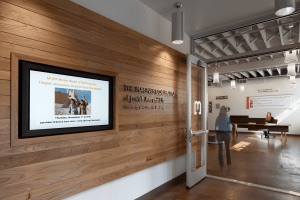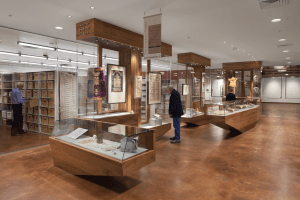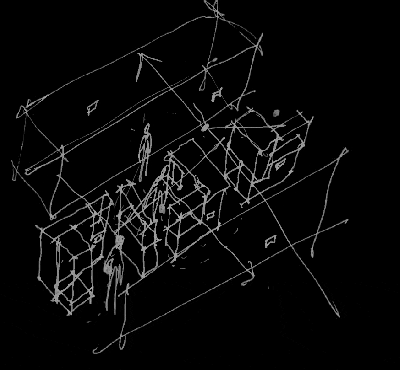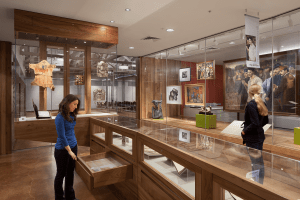For the firm's first blog topic, Peter Pfau, principal-in-charge, and Natalie Kittner, project architect, discuss the recently completed The Magnes Collection of Jewish Art and Life at UC Berkeley. It opened earlier this year.

Q. What are the challenges of utilizing a former printing plant?
Peter: There is a certain sensibility about an existing place, one that has its own character. We didn't want to detract from that, but rather allow the nature of the Deco-era building speak for itself. From the start, our plans were to reveal what's honest and direct about the building's original design.
Natalie: Indeed, our design is entirely about respecting the building's history and moving it along to a new life, a new purpose, and that is what we've created for the Magnes.
Q. The Magnes is now in downtown Berkeley. Were other sites considered?
Peter: The Magnes Collection was previously located in a south Berkeley residential neighborhood. A couple other ground-up and historic renovation ideas were considered, but were deemed too expensive. Repurposing the former printing plant was not only cost-effective, but also it was in a prime location in the Berkeley Downtown Arts District.
Q. What did Pfau Long Architecture do to the building?
Peter: The interventions for the old building were fairly low key; we wanted to focus on the magic of the user experience. We retained the existing structure, the exterior windows, the floor... they all tell a story of what was there before. In an earlier iteration, the building had been a storage site for the Bancroft Library and bookcases had been bolted directly into the concrete floor. We patched the holes and stained the floor; the history remains evident.

Q. Can you explain the "immersion idea" for the user experience?
Natalie: This idea was something Magnes Collection of Art and Life at UC Berkeley Director Alla Efimova, and Curator Francesco Spagnolo were interested in, and had been explored in only a few other museums. So, it was on the table when we were brought in; our task was to figure out how to realize it in relation to this collection... and make it central to the Magnes Collection experience. Most museums only offer a pre-scripted, start-to-finish linear experience, where the curators guide your perception of the collection. The Magnes wanted to challenge the conventional curatorial mode: they wanted the visitor to realize the depth and extent of the collection and to be encouraged to guide their own exploration.
Peter: I created a sketch in an early team meeting, and it proved generative of the approach we ended up building. One enters the museum and immediately sees the three key elements: the central exhibition space and to either side, the conservator ship area where staff prepare materials and opposite it the archival stacks. Glass walls separate, but don't hide, the various elements of the collection. It's all there to be seen and to engage the imagination.

Q. You speak of the team. Were there other people involved?
Natalie: Yes. In particular Pacassa Studio of West Oakland was a key collaborator. They helped conceive and build the exquisitely detailed cabinetry and exhibit structures. They also became part of a "design alliance" where all members were working to realize a common goal: to make the immersive concepts a functional and esthetically compelling reality.
Peter: Joining early on with Pacassa Studio, and others, resulted in a successful collaboration, one that brought together budget and spirit. If you can identify the trust of shared objectives, the other designers and fabricators can share in the design process with how the designs will actually be made. If we had put those ideas out to bid, it would have been far more complicated and expensive. The notion of creating increased collaboration with thoughtful participants is what interested us, and the result is a good proof of concept
Q. Is the immersion experience setting a standard?
Peter: Yes. The Magnes Collection of Jewish Art and Life at UC Berkeley is not the first institution to toy with this; portions of the Brooklyn Museum in New York were already utilizing the idea. But the Magnes is definitely raising the bar on how thoroughly it can be done. The result is strikingly compelling, the visitor actually becomes one with the archive, and interested in exploring what it contains. It's well worth a visit.

